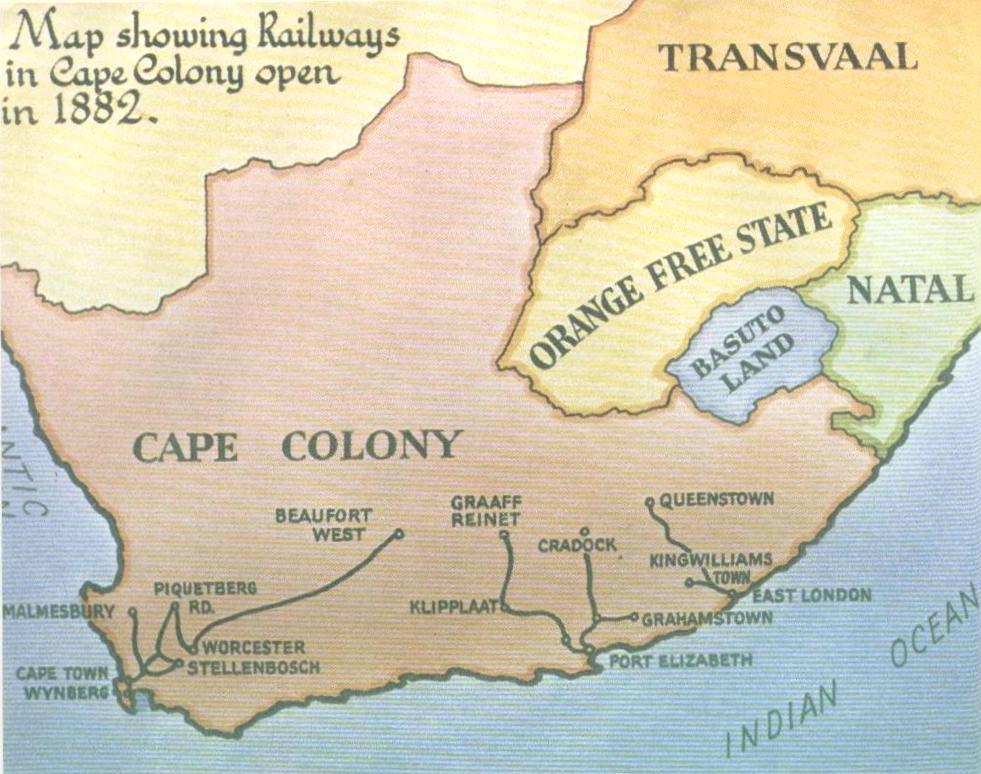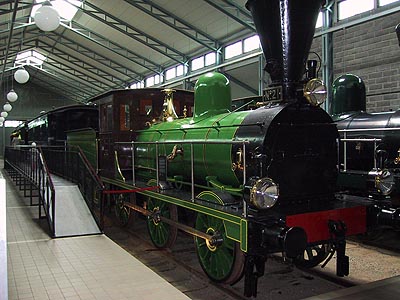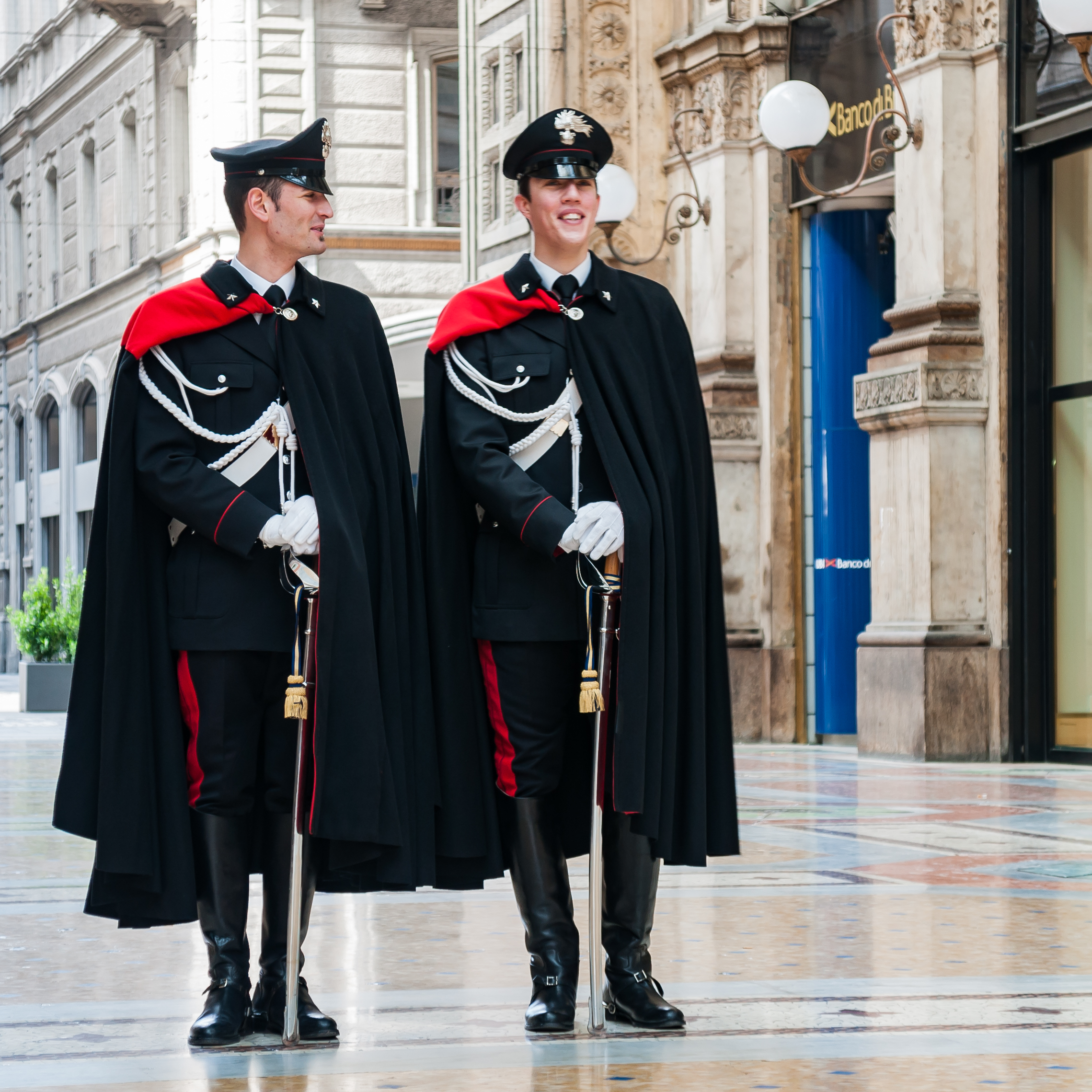|
CGR 3rd Class 4-4-0 1883
The Cape Government Railways 3rd Class 4-4-0 of 1883 was a South African steam locomotive from the pre-Union era in the Cape of Good Hope. In 1882, the Cape Government Railways placed orders with Neilson and Company for eighteen 3rd Class tender locomotives with a 4-4-0 American type wheel arrangement. They were intended for fast passenger service on all three Cape Systems and were delivered early in 1883.''C.G.R. Numbering Revised'', Article by Dave Littley, SA Rail May–June 1993, pp. 94-95.Espitalier, T.J.; Day, W.A.J. (1943). ''The Locomotive in South Africa - A Brief History of Railway Development. Chapter II - The Cape Government Railways'' (Continued). South African Railways and Harbours Magazine, November 1943. pp. 811-812, 818. Manufacturer Eighteen 4-4-0 American type tender passenger locomotives were delivered to the Cape Government Railways (CGR) from Neilson and Company in 1883. They were numbered in the ranges from W77 to W88 for the Western System, E15 and E16 f ... [...More Info...] [...Related Items...] OR: [Wikipedia] [Google] [Baidu] |
Neilson And Company
Neilson and Company was a locomotive manufacturer in Glasgow, Scotland. The company was started in 1836 at McAlpine Street by Walter Neilson and James Mitchell to manufacture marine and stationary engines. In 1837 the firm moved to Hyde Park Street and was known as Kerr, Mitchell and Neilson and, in 1840, Kerr, Neilson and Company, becoming Neilson and Mitchell in 1843. Locomotive building began in 1843 for the local railways. In 1855 production of marine and stationary engines discontinued and the company changed its name again to Neilson and Company. Among those who later became notable in the field were Henry Dübs and Patrick Stirling. By 1861, business had increased to such an extent, that a new works was built at Springburn, also named "Hyde Park Works." In 1864, Henry Dübs set up in business on his own at Queens Park Works, as Dübs and Company, taking a number of key staff with him. James Reid, who had previously worked for Neilson, however, returned and became ... [...More Info...] [...Related Items...] OR: [Wikipedia] [Google] [Baidu] |
Cape Government Railways Map - 1882 - Cape Archives
A cape is a clothing accessory or a sleeveless outer garment which drapes the wearer's back, arms, and chest, and connects at the neck. History Capes were common in medieval Europe, especially when combined with a hood in the chaperon. They have had periodic returns to fashion - for example, in nineteenth-century Europe. Roman Catholic clergy wear a type of cape known as a ferraiolo, which is worn for formal events outside a ritualistic context. The cope is a liturgical vestment in the form of a cape. Capes are often highly decorated with elaborate embroidery. Capes remain in regular use as rainwear in various military units and police forces, in France for example. A gas cape was a voluminous military garment designed to give rain protection to someone wearing the bulky gas masks used in twentieth-century wars. Rich noblemen and elite warriors of the Aztec Empire would wear a tilmàtli; a Mesoamerican cloak/cape used as a symbol of their upper status. Cloth and clothing w ... [...More Info...] [...Related Items...] OR: [Wikipedia] [Google] [Baidu] |
CGR Locomotives
{{disambig ...
CGR may refer to: * Campo Grande International Airport (IATA airport code) * Canadian Government Railways * Cape Government Railways * Center for Governmental Research * Ceylon Government Railway * Chip Ganassi Racing * Classic Game Room * Commercial gramophone record – see Spelling of disc * Condensate to Gas Ratio * Contraloría General de la República de Costa Rica * Cyprus Government Railway The Cyprus Government Railway was a narrow gauge railway network that operated in Cyprus from October 1905 to December 1951. With a total length of , there were 39 stations, stops and halts, the most prominent of which served Famagusta, Prasti ... [...More Info...] [...Related Items...] OR: [Wikipedia] [Google] [Baidu] |
Queen Victoria
Victoria (Alexandrina Victoria; 24 May 1819 – 22 January 1901) was Queen of the United Kingdom of Great Britain and Ireland from 20 June 1837 until her death in 1901. Her reign of 63 years and 216 days was longer than that of any previous British monarch and is known as the Victorian era. It was a period of industrial, political, scientific, and military change within the United Kingdom, and was marked by a great expansion of the British Empire. In 1876, the British Parliament voted to grant her the additional title of Empress of India. Victoria was the daughter of Prince Edward, Duke of Kent and Strathearn (the fourth son of King George III), and Princess Victoria of Saxe-Coburg-Saalfeld. After the deaths of her father and grandfather in 1820, she was raised under close supervision by her mother and her comptroller, John Conroy. She inherited the throne aged 18 after her father's three elder brothers died without surviving legitimate issue. Victoria, a constitu ... [...More Info...] [...Related Items...] OR: [Wikipedia] [Google] [Baidu] |
Central South African Railways
The Central South African Railways (CSAR) was from 1902 to 1910 the operator of public railways in the Transvaal Colony and Orange River Colony in what is now South Africa. During the Anglo-Boer War, as British forces moved into the territory of the Orange Free State and the South African Republic, the Orange Free State Government Railways, the Netherlands-South African Railway Company and the Pretoria-Pietersburg Railway were taken over by the Imperial Military Railways under Lieutenant-Colonel Sir Percy Girouard. After the war had ended, the Imperial Military Railways became the Central South African Railways in July 1902, with Thomas Rees Price as general manager. With the creation of the Union of South Africa in 1910, the CSAR was merged with the Cape Government Railways and the Natal Government Railways to form the South African Railways, which is now Transnet Freight Rail. References Further reading * Defunct railway companies of South Africa Railway companies estab ... [...More Info...] [...Related Items...] OR: [Wikipedia] [Google] [Baidu] |
Natal Government Railways
The Natal Government Railways (NGR) was formed in January 1877 in the Colony of Natal. In 1877, the Natal Government Railways acquired the Natal Railway Company for the sum of £40,000, gaining the line from the Point to Durban and from Durban to Umgeni. This move, inspired in part by the neighbouring Cape Prime Minister John Molteno's 1873 establishment of the Cape Government Railways, was intended to drive the extension of Natal's railways inland, towards the Drakensberg and eventually the Orange Free State. The Natal Government Railways also adopted the Cape gauge. The core line went from Durban to Volksrust, but reached Charlestown ( from the border of the South African Republic) in 1891 and was linked to the Witwatersrand in 1895. Other important lines were the one linking with the Orange Free State reaching Harrismith in 1892, as well as the North Coast and South Coast lines. In 1910, the Union of South Africa was formed and in 1912 the NGR combined with the other colo ... [...More Info...] [...Related Items...] OR: [Wikipedia] [Google] [Baidu] |
Malmesbury, Western Cape
Malmesbury is a town of approximately 36,000 inhabitants in the Western Cape province of South Africa, about 65 km north of Cape Town. The town is the largest in the Swartland (‘black land’) which took its name from the Renosterbos ('rhino bush'), an indigenous plant that turns black in the warm, dry summers. The area is especially known for its grain and wine cultivation as well as sheep and poultry farming. Malmesbury was named after Sir Lowry Cole's father-in-law, the Earl of Malmesbury. Settlers were encouraged to make their homes here because of a tepid sulphur chloride mineral spring that was renowned for curing rheumatism. The first farms were allocated in 1703. When the fifth Dutch Reformed congregation in the Cape was established here, it became known as Zwartlands-kerk (Swartland Church) but was renamed Malmesbury in 1829. The town acquired municipal status in 1860. The town no longer attracts the ailing because this aspect was never developed by the local ... [...More Info...] [...Related Items...] OR: [Wikipedia] [Google] [Baidu] |
De Aar
De Aar is a town in the Northern Cape province of South Africa. It has a population of around 42,000 inhabitants. It is the second-most important railway junction in the country, situated on the line between Cape Town and Kimberley. The junction was of particular strategic importance to the British during the Second Boer War. De Aar is also a primary commercial distribution centre for a large area of the central Great Karoo. Major production activities of the area include wool production and livestock farming. The area is also popular for hunting, although the region is rather arid. De Aar is also affectionately known as "Die SES" deriving its nickname from the six farms that have surrounded De Aar since the 1900s. History De Aar was originally established on the Farm "De Aar." The name means "the artery," a reference to its underground water supply. The Cape Government Railways were founded in 1872, and the route that the government chose for the line to connect the Kimberle ... [...More Info...] [...Related Items...] OR: [Wikipedia] [Google] [Baidu] |
Grahamstown
Makhanda, also known as Grahamstown, is a town of about 140,000 people in the Eastern Cape province of South Africa. It is situated about northeast of Port Elizabeth and southwest of East London. Makhanda is the largest town in the Makana Local Municipality, and the seat of the municipal council. It also hosts Rhodes University, the Eastern Cape Division of the High Court, the South African Library for the Blind (SALB), a diocese of the Anglican Church of Southern Africa, and 6 South African Infantry Battalion. Furthermore, located approximately 3 km south-east of the town lies the world renowned Waterloo Farm, the only estuarine fossil site in the world from 360 million years ago with exceptional soft-tissue preservation. The town's name-change from Grahamstown to Makhanda was officially gazetted on 29 June 2018. The town was officially renamed to Makhanda in memory of Xhosa warrior and prophet Makhanda ka Nxele. History Founding Makhanda was founded as Grahamsto ... [...More Info...] [...Related Items...] OR: [Wikipedia] [Google] [Baidu] |
Cradock, Eastern Cape
Cradock is a town in the Eastern Cape Province of South Africa, in the upper valley of the Great Fish River, by road northeast of Port Elizabeth. The town is the administrative seat of the Inxuba Yethemba Local Municipality in the Chris Hani District of the Eastern Cape. The town is named after John Cradock, governor of the Cape Colony and commander of the forces. Pre-colonial history For thousands of years San hunter-gatherers were the sole human inhabitants of southern Africa. About 2000 years BP the semi-nomadic Khoikhoi (or Khoekhoen or Khoikhoin) arrived with cattle, sheep and goats. These pastoralists migrated south towards the coast. Rock paintings and petroglyphs (engravings) remain as evidence of the first people who lived here. By the 4th century AD Bantu-speaking people had begun to migrate from central Africa down the east coast into southern Africa. The amaXhosa pressed further south to the banks of the Great Fish River where they met San hunter-gatherer ... [...More Info...] [...Related Items...] OR: [Wikipedia] [Google] [Baidu] |
Rosmead
Rosmead is a village 12 km east of Middelburg and 75 km west-south-west of Steynsburg. It was founded in 1880 and at first named Middelburg Road, but renamed in 1883 after Sir Hercules George Robinson, Lord Rosmead (1824–1897), who was Governor of the Cape Colony This article lists the governors of British South African colonies, including the colonial prime ministers. It encompasses the period from 1797 to 1910, when present-day South Africa was divided into four British colonies namely: Cape Colony ( ... from 1880 to 1889. References Populated places in the Inxuba Yethemba Local Municipality {{EasternCape-geo-stub ... [...More Info...] [...Related Items...] OR: [Wikipedia] [Google] [Baidu] |




_-_Copy.jpg)
